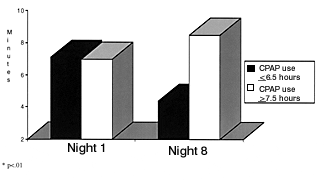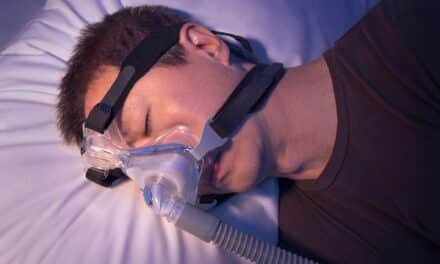Gender differences in the prevalence of sleep apnea are due to differences in pharyngeal length, upper airway cross-sectional area, and the hypocapnic apneic threshold.

OSA is more common in men than in women. Clinic-based studies overestimated gender difference in the prevalence of sleep apnea. This may be due to referral bias and to the prevailing erroneous notion that sleep apnea syndrome is a male disease; however, recent community-based epidemiologic studies1-3 have confirmed the gender difference in the prevalence of sleep apnea, albeit to a lesser magnitude. For example, the Wisconsin Sleep Cohort Study revealed that then prevalence of sleep apnea syndrome was 2% in women and 4% in men. Sleep apnea/hypopnea syndrome was defined as an apnea/hypopnea index (AHI) of five or more events per hour of sleep, combined with daytime sleepiness.1 A more recent study by Bixler et al3 has reached similar conclusions regarding the prevalence, regardless of the definition used to identify the disorder. Interestingly, the study also noted the paucity of central apnea in women relative to men. Overall, there is a strong male predominance in clinic-based reports and a smaller gender difference in community-based studies; however, gender cannot be used as a criterion to exclude the condition.
The consistent difference between clinical and community-based studies raises the likelihood that women are missed either because of differences in presentation or because physicians fail to recognize the symptoms in women.4,5 Some studies have shown that women report more fatigue6 or more difficulty in initiating and maintaining sleep7; however, whether clinical presentations are similar or different remains an open question. Finally, women in the working population enrolled in the Wisconsin Sleep Cohort Study reported more daytime sleepiness even in cases of mild or no sleep apnea.8
Differences in Polysomnography
Several studies have investigated whether polysomnographic features are different in men versus women.9,10 There is agreement that AHI is lower in women relative to men when matched for body weight. This is mostly due to higher AHI during non-rapid eye movement (NREM) in men relative to women. Interestingly, apneas and hypopneas tend to occur during REM sleep in women, whereas men tend to demonstrate more supine dependence than women do. There is no clear explanation for the difference in polysomnography between genders, but it may reflect differences in mechanism between REM and NREM sleep.
Mechanisms of Gender Difference
Upper Airway Structure and Function
The pharyngeal airway is susceptible to collapse owing to the absence of bony or cartilaginous structural support. Thus, patency of the pharyngeal airway depends on the length of the collapsible segment, caliber of the pharyngeal lumen, stiffness of the pharyngeal wall, and the pressure gradient across the pharyngeal wall. The sleep state is conducive to pharyngeal narrowing or closure by virtue of increased upper airway resistance and collapsibility.
A difference in upper airway dimensions between men and women may contribute to pharyngeal closure during sleep. Some studies, but not others, revealed that pharyngeal cross-sectional area is smaller in women relative to men. This finding could not explain the higher prevalence of sleep-disordered breathing among men relative to women. In contrast, there is gender difference in pharyngeal airway length. Using magnetic resonance image scanning, Malhotra et al11 demonstrated a greater pharyngeal airway length in men relative to women, even when corrected for height. Given the fact that the pharyngeal airway is the section vulnerable to collapse, a longer airway is a more vulnerable airway.
The current understanding of the determinants of upper airway patency during sleep suggests a complex interplay between intrinsic mechanical properties of the pharynx and neural regulation of pharyngeal dilator muscle activities. Therefore, the effects of gender on pharyngeal structure and function during sleep defy simple descriptors. For example, upper airway resistance, collapsibility, compliance, and critical closing pressure are distinct properties of the pharyngeal airway with different determinants. There is no conclusive evidence of a gender difference in upper airway resistance or collapsibility during NREM sleep.12-14 In contrast, Pillar et al15 found that hypoventilation in response to an external inspiratory load is more pronounced in men relative to women. Finally, pharyngeal compliance during sleep is higher in men relative to women, suggesting a higher susceptibility to collapse16; this difference in compliance is due to differences in neck circumference between both genders.
Ventilatory Control
Most studies exploring interaction between gender and ventilatory control were conducted during wakefulness. In general, there are no consistent gender differences in hypoxic and hypercapnic chemoresponsiveness; however, chemoresponsiveness is an important determinant of breathing stability in response to transient perturbation, especially during sleep. For example, an excessive ventilatory response to hypoxia may cause a reduction in arterial CO2 below normal levels. During wakefulness, ventilation remains stable despite hypocapnia, owing to the wakefulness drive to breathe. During NREM sleep, the removal of the wakefulness drive to breathe renders ventilation critically dependent on central and peripheral chemoreflexes. In fact, sleep unmasks a highly sensitive, hypocapnic apneic threshold. If arterial Pco2 is lowered sufficiently, central apnea ensues. The level of Paco2 associated with central apnea is referred to as the apneic threshold.17 Zhou et al18 have demonstrated that the hypocapnic apneic threshold is elevated in men relative to women. This suggests that induction of central apnea in men is more feasible and requires lesser magnitude of hyperventilation.
The occurrence of central apnea may contribute to recurrent apnea and breathing instability. A common adage is that “apnea begets apnea.” Central apnea may initiate several processes including hypoxia and transient arousal with subsequent ventilatory overshoot, hypocapnia, and recurrent central apnea. A less recognized phenomenon is that central apnea may also influence the development of OSA. There is evidence that central apnea is associated with pharyngeal narrowing or occlusion in patients with susceptibility to upper airway collapse,19 such as patients with OSA. The occurrence of complete pharyngeal collapse during central apnea, combined with mucosal and gravitational factors, may impede pharyngeal opening and necessitate a substantial increase in drive that eventually leads to the sequence of events.
Conclusion
The prevalence of sleep apnea is higher in men relative to women, independent of referral bias. While no unifying explanation is proven, three factors may contribute to the noted gender difference, namely differences in pharyngeal length, upper airway cross-sectional area, and hypocapnic apneic threshold. The relative contribution of each factor to the pathogenesis of sleep apnea is yet to be determined.
Safwan Badr, MD, is professor and chief, Division of Pulmonary, Critical Care, and Sleep Medicine, Wayne State University, Harper University Hospital, Detroit.
References
1. Young T, Palta M, Dempsey J, Skatrud J, Weber S, Badr S. The occurrence of sleep-disordered breathing among middle-aged adults. N Engl J Med. 1993;328:1230-1235.
2. Bixler EO, Vgontzas AN, Ten Have T, Tyson K, Kales A. Effects of age on sleep apnea in men. I. Prevalence and severity. Am J Respir Crit Care Med. 1998;157:144-148.
3. Bixler EO, Vgontzas AN, Lin HM, et al. Prevalence of sleep-disordered breathing in women: effects of gender. Am J Respir Crit Care Med. 2001;163:608-613.
4. Redline S, Kump K, Tishler PV, Browner I, Ferrette V. Gender differences in sleep-disordered breathing in a community-based sample. Am J Respir Crit Care Med. 1994;149:722-726.
5. Young T. Analytic epidemiology studies of sleep-disordered breathing—what explains the gender difference in sleep-disordered breathing. Sleep. 1993;16:S1-S2.
6. Chervin RD. Sleepiness, fatigue, tiredness, and lack of energy in obstructive sleep apnea. Chest. 2000;118:372-379.
7. Baldwin CM, Griffith KA, Nieto FJ, O’Connor GT, Walsleben JA, Redline S. The association of sleep-disordered breathing and sleep symptoms with quality of life in the Sleep Heart Health Study. Sleep. 2001;24:96-105.
8. Young T, Palta M, Badr MS. Sleep-disordered breathing [letter]. N Engl J Med. 1993;329:1429-1430.
9. O’Connor C, Thornley KS, Hanly PJ. Gender differences in the polysomnographic features of obstructive sleep apnea. Am J Respir Crit Care Med. 2000;161:1465-1472.
10. Ware JC, McBrayer RH, Scott JA. Influence of sex and age on duration and frequency of sleep apnea events. Sleep. 2000;23:165-170.
11. Malhotra A, Huang Y, Fogel RB, et al. The male predisposition to pharyngeal collapse: importance of airway length. Am J Respir Crit Care Med. 2002;166:1388-1395.
12. Rowley JA, Zhou ZS, Vergine I, Shkoukani BS, Badr MS. The influence of gender on upper airway mechanics: upper airway resistance and Pcrit. J Appl Physiol. 2001;91:2248-2254.
13. Thurnheer R, Wraith PK, Douglas NJ. Influence of age and gender on upper airway resistance in NREM and REM sleep. J Appl Physiol. 2001;90:981-988.
14. Trinder J, Kay A, Kleiman J, Dunai J. Gender differences in airway resistance during sleep. J Appl Physiol. 1997;83:1986-1997.
15. Pillar G, Malhotra A, Fogel R, Beauregard J, Schnall R, White DP. Airway mechanics and ventilation in response to resistive loading during sleep: influence of gender. Am J Respir Crit Care Med. 2000;162:1627-1632.
16. Rowley JA, Sanders CS, Zahn BK, Badr MS. Gender differences in upper airway compliance during NREM sleep: role of neck circumference. J Appl Physiol. 2002;92:2535-2541.
17. Skatrud JB, Dempsey JA. Interaction of sleep state and chemical stimuli in sustaining rhythmic ventilation. J Appl Physiol. 1983;55:813-822.
18. Zhou XS, Shahabuddin S, Zahn BK, Babcock MA, Badr MS. Effect of gender on the development of hypocapnic apnea/hypopnea during NREM sleep. J Appl Physiol. 2000;89:192-199.
19. Badr M, Toiber SF, Skatrud JB, Dempsey J. Pharyngeal narrowing/occlusion during central sleep apnea. J Appl Physiol. 1995;78:1806-1815.



